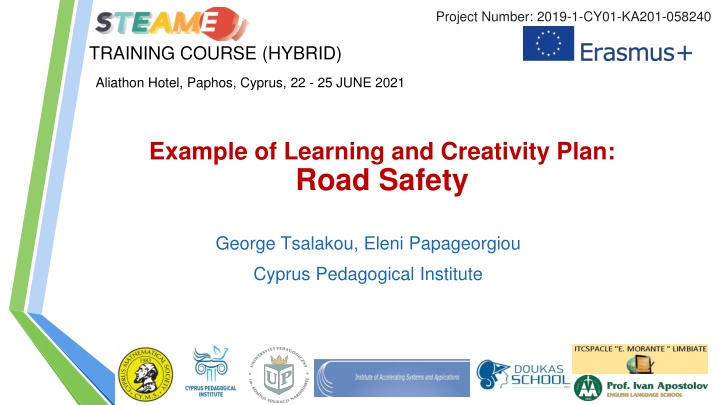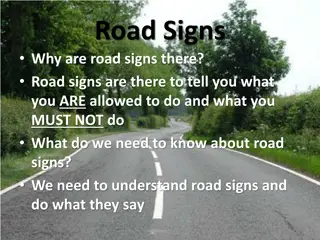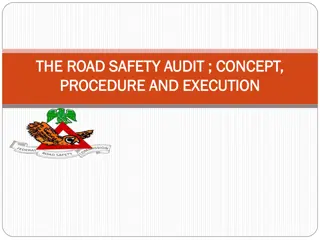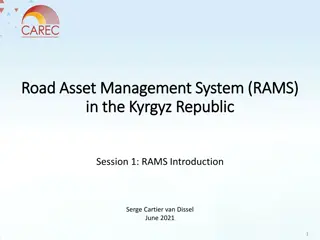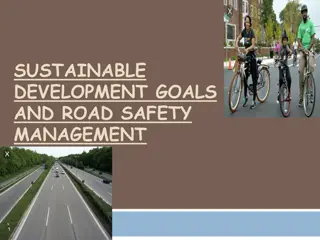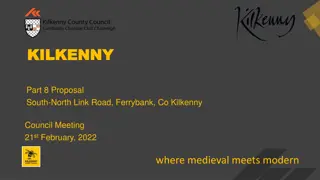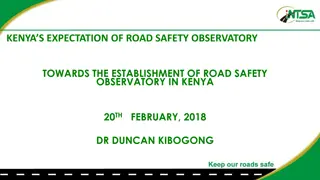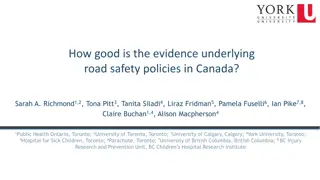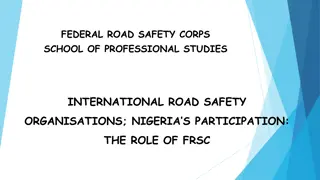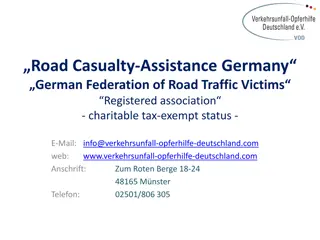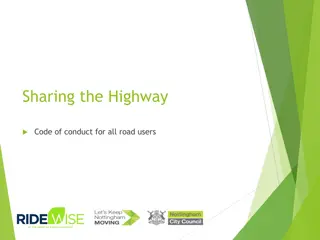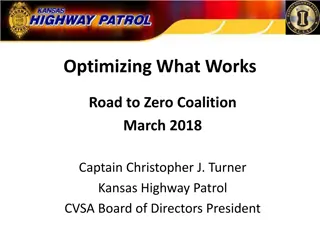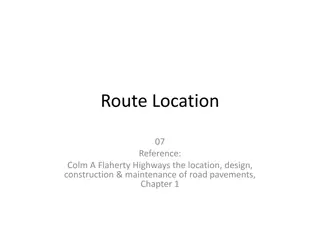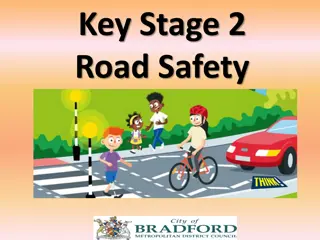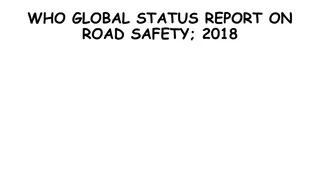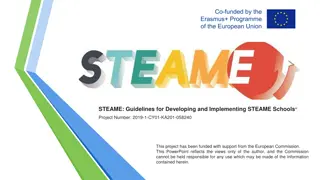Road Safety Learning Plan for Students Ages 16-18: STEAME Approach
Engage high school students in a comprehensive road safety learning plan, incorporating STEAME disciplines - Science, Technology, Engineering, Arts, Mathematics, and Economics. The plan focuses on reducing road accidents and casualties through integrated activities like physics experiments, statistical analysis, art projects, theater productions, and community initiatives. Students will investigate causes of accidents, evaluate car safety systems, and explore citizen responsibilities, fostering a deep understanding of road safety issues.
Download Presentation

Please find below an Image/Link to download the presentation.
The content on the website is provided AS IS for your information and personal use only. It may not be sold, licensed, or shared on other websites without obtaining consent from the author.If you encounter any issues during the download, it is possible that the publisher has removed the file from their server.
You are allowed to download the files provided on this website for personal or commercial use, subject to the condition that they are used lawfully. All files are the property of their respective owners.
The content on the website is provided AS IS for your information and personal use only. It may not be sold, licensed, or shared on other websites without obtaining consent from the author.
E N D
Presentation Transcript
Project Number: 2019-1-CY01-KA201-058240 TRAINING COURSE (HYBRID) Aliathon Hotel, Paphos, Cyprus, 22 - 25 JUNE 2021 Example of Learning and Creativity Plan: Road Safety George Tsalakou, Eleni Papageorgiou Cyprus Pedagogical Institute
TRAINING COURSE Module 2 An example of STEAME Learning and Creativity Plans Road Safety 1. Overview Title Driving Question or Topic Ages, Grades, Road safety How to reduce road accidents and casualies? Ages: 16-18 Grades: 10th- 11thgrade Duration, Timeline, Activities Curriculum Alignment Physics (collisions, friction), Mathematics (Statistics), Art (Poster design), Theatre (Video clip creation), Technology (Graphic Design software, Forms, Excel), Engineering (car safety systems), Logistics (Costs) 25X45 min, 6 activities S T Eng A M Ent X X X X X X
An example of STEAME Learning and Creativity Plans Road Safety The context A real-life problem is the road accidents, which cause deaths, injuries and property damage. There is an urgent need to improve road safety. The investigation (Inquiry) Research on various parameters related to road accidents: 1. What are the causes of road accidents? 2. How much do the safety systems of a car protect us from serious injuries? 3. What do people think about the causes of road accidents and the measures that need to be taken to reduce them? 4. What measures could be taken in the community where the school is located to reduce road accidents?
Students Students NOT TEACHER DIRECTED STUDENTS ARE LEARNING THE SKILLS TO SYNTHESIZE, INTERPRET & EVALUATE
Teachers. Teachers .
Road Safety 2. STEAME Framework Teachers Cooperation Teacher 1 (T1-Physics) Teacher 2 (T2-Mathematics) Teacher 3 (T3-Art) Teacher 4 (T4-Theatrology) Teacher 5 (T5- Economics) Teacher 6 (T6-Computer Science)
Road Safety 3. Objectives and Methodologies Learning Goals and Objectives 1. To plan and carry out experimental activities for investigation: the role of the seat belt in a car the role of the airbag in a car the dependence of the braking distance of a car on its speed 2. Collect and record data using various methods, such as observation, measurement / recording 3. To process statistical data and correlate variables. 4. Understand the role of the active citizen. 1. Experimental data on the force exerted on a body during impact on a surface and in an airbag as a function of the velocity of the body during impact. 2. Experimental data for the vehicle braking distance as a function of vehicle speed before braking. 3. Experiment video on the role of the seat belt in a car. 4. Questionnaire to investigate the views of a specific population on road safety issues. 5. Poster for raising community awareness on road safety issues. 6. Video clips to raise community awareness on road safety issues. 7. Economic study on the cost of a measure to improve road safety (eg installation of cameras in traffic lights). Learning Outcomes and expected Results
Road Safety 3. Objectives and Methodologies Prior Knowledge and Prerequisites 3. Basic knowledge of design program in computer. Motivation, Methodology, Strategies, Scaffolds the ways of conducting these surveys. Teachers intervene when students have 1. Basic knowledge of descriptive statistics and use of spreadsheets (excel). 2. Knowledge of using motion and power sensors Inquiry based learning approach, working in groups with collaborative learning. The surveys given by the teachers are open and the students are invited to design difficulty planning investigations or have not considered all aspects of the problem
Road Safety 4. Preparation and Means Resources, Tools, Material, Attachments, Equipment For the role of Physics in road safety and for exploration ideas https://www.scienceinschool.org/content/look-out-physics-road-safety https://www.mynrma.com.au/-/media/documents/motoring-education/study- guides/nrma-the-road-safety-total-learning-resource-years-9-10.pdf?la=en https://www.sci-ed-ga.org/staying-alive https://roadsafety.scot/wp-content/uploads/2017/08/Neale-Kinnear-Changing- speed-limits-Implications-for-road-safety.pdf https://www.youi.com.au/youi-news/road-safety-week-the-physics-of-speeding https://learn.teachingchannel.com/video/8th-grade-science-motion http://www.fisme.science.uu.nl/toepassingen/28754/
Road Safety 4. Preparation and Means Resources, Tools, Material, Attachments, Equipment Data collection methods - Sampling methods and techniques - Construction and use of appropriate questionnaires (paper or electronic) - Methods of checking the validity and reliability of the questionnaire (use of appropriate software) - Methods of statistical analysis and presentation of results - use of results (use of appropriate results) detailed research report Links to the Learning and Creativity Plan of the STEAME program Research Services Evaluation Physics laboratory with cars, motion and force sensors. Computers with video design and editing programs Collection of information on the number of road collisions and their characteristics o Traffic departments of the Police or the municipality
Road Safety 5. Implementation Instructional Activities, Procedures, Reflections The L&C plan can be implemented in 25 periods. In the 1st period, T1 and T2 discuss with the department and through an ideological storm record the aspects of road safety that need to be investigated. T1 and T2 guide the class, if necessary, indicating factors not mentioned. Then the actions that the groups will deal with are divided, with some actions, directly related to the syllabus being common to all groups. The course of the group work, the collaboration with the other teachers, the way of receiving feedback and the method of evaluating the work of each group are determined. Students are invited to study the material at the links mentioned above for road safety.
Road Safety 5. Implementation Instructional Activities, Procedures, Reflections The Physics of Impacts (4 periods) T1 teaches the Physics of collisions and instructs teams to design and perform experimental activities to explore the following: The force exerted when a body hits a hard surface (car dashboard) and a soft one (airbag). What will happen to a car passenger in a road collision, if he/she has not put on a seat belt. How the braking speed of a vehicle changes relative to the vehicle speed before braking. How does this distance depend on the condition of the road. Each group undertakes to investigate one of the above factors and presents to the plenary the results of the investigation.
Road Safety 5. Implementation Instructional Activities, Procedures, Reflections 2. Collection, statistical processing of data and their presentation. (6 periods) T2 and T6 help students to collect data on the views of a certain group of people (eg schoolchildren) about the causes of road accidents and how to reduce them and, at the same time, to obtain data from the competent authorities on road collisions and their causes. 3. Design a poster to raise public awareness about road safety. (3 periods) T3 guides teams in theme selection and poster design. Each group can deal with a different issue of road safety (eg use of seat belt, observance of the speed limit, avoidance of driving under the influence of alcohol, non-use of mobile phone while driving, etc.)
Road Safety 5. Implementation Instructional Activities, Procedures, Reflections Costing of a measure to improve road safety. (3 periods) With the help of the T4, the teams undertake to cost the implementation of a measure, which will improve road safety (eg installation of cameras at road junctions, continuous surveillance of motorways to exceed the speed limit, withdrawal of cars without airbags, etc. a.). Creating a script for video clips for road safety (4 periods) T5 guides teams to create a common road safety video clip. Each group can contribute material from the actions they have already carried out. Presentation of results - Preparation of a detailed research report (4 periods) Each group prepares a presentation with the results of the actions it has implemented. The groups turn to the teachers for help, depending on the action. T1 T6 provide ongoing support, feedback and evaluation.
Road Safety 5. Implementation Assessment - Evaluation The feedback and evaluation is continuous throughout the actions until the presentation of the results. Presentation - Reporting - Sharing The presentation of the results can be done for the student community of the school, but findings from the research of the groups can be communicated to competent bodies of the community (e.g., Municipal Council, Police, etc.). The work of the class can be the beginning of a more general effort to raise the Extensions Other information awareness of the entire student population and the community on road safety issues in collaboration with relevant bodies.
Thanks for your attention! Any questions?
